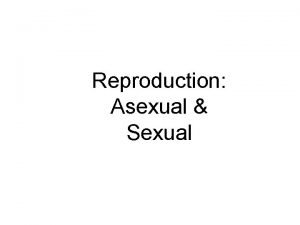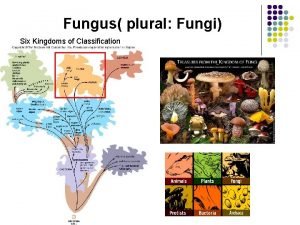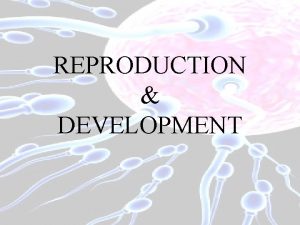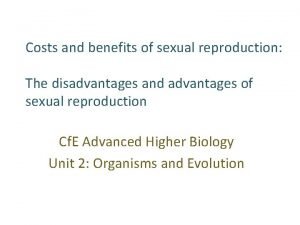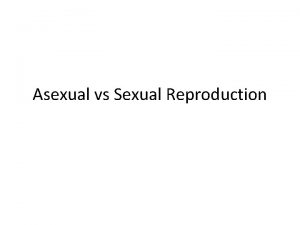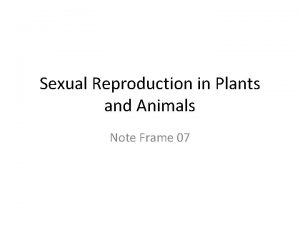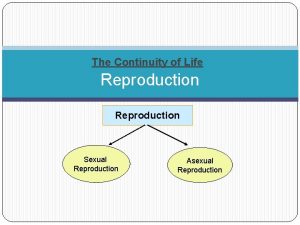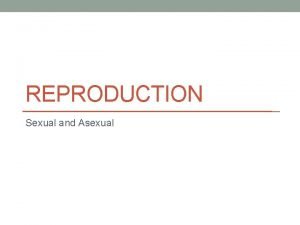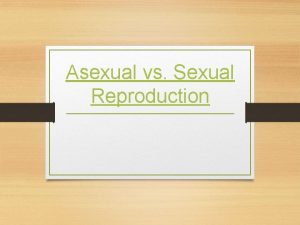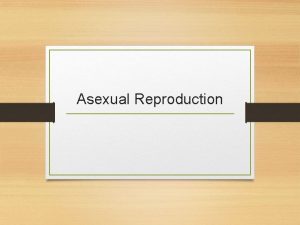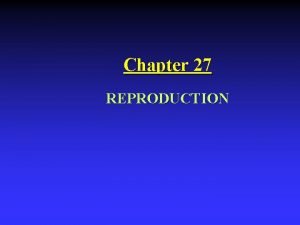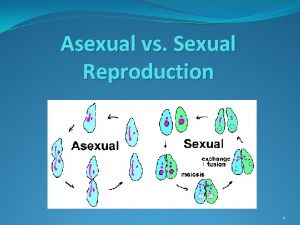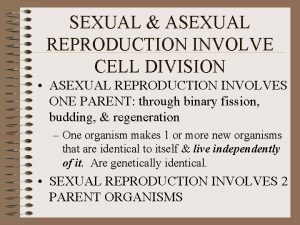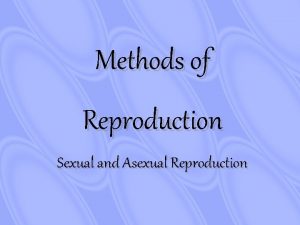CELLULAR REPRODUCTION Asexual Vs Sexual Reproduction ASEXUAL REPRODUCTION

















- Slides: 17

CELLULAR REPRODUCTION Asexual Vs Sexual Reproduction

ASEXUAL REPRODUCTION • Single parent passes complete copy of genetic information to its offspring • Identical to parent • Four types • Binary fission • Fragmentation • Budding • Parthenogenesis

BINARY FISSION • DNA duplicates • Cell grows • Cell splits

FRAGMENTATION • Body breaks into several pieces and grow new parts or a whole organism

BUDDING • New individuals split off from existing ones

PARTHENOGENESIS • Female makes viable egg that grows into an adult without being fertilized by male

SEXUAL REPRODUCTION • Genetic material given to offspring by two individuals • Offspring are genetically different from parents • Gametes • Reproductive cell (sperm or egg) • Division of germ cell • Haploid cells created through meiosis • Union produces zygote

MEIOSIS • Cell reduces chromosome number in new cells to half the number of the original cell • Sperm and egg (1 n each, haploid) • Combine result in zygote (2 n, diploid)


MEIOSIS • Interphase • Begins with duplicate set of chromosomes like mitosis • Two divisions results in four (1 n, haploid) cells • Meiosis I and Meiosis II

MEIOSIS I • Prophase • Chromosomes condense • Spindle fibers form • Homologous chromosomes line up next to each other (synapsis) • Tetrads align side by side • Twist around each other • Portion breaks off to the adjacent chromatid • Crossing – over results in new mix of genetic information

MEIOSIS I • Similar to mitosis • Metaphase I • Anaphase I • Independent assortment • Telophase I • Results in two cells with a chromosome from each pair of homologous chromosomes

MEIOSIS II • Prophase II, no duplication of chromosomes • Metaphase II • Anaphase II • Chromatids separate • Telophase II • Cytokinesis II • 4 new genetically different haploid cells


GENETIC VARIATION • Crossing – over • Independent assortment • Random fertilization

DEVELOPMENT OF GAMETES • Testes in males • Spermatogenesis to create sperm • Ovaries in females • Oogenesis to create ova • 1 egg and 3 polar bodies

KARYOTYPE
 Sexual reproduction and asexual reproduction
Sexual reproduction and asexual reproduction Asexual vs sexual venn diagram
Asexual vs sexual venn diagram Binary fission in bacteria
Binary fission in bacteria Advantages of genetic diversity
Advantages of genetic diversity Parthenogenesis
Parthenogenesis Fungus diagram
Fungus diagram Asexual or sexual reproduction
Asexual or sexual reproduction Asexual and sexual reproduction venn diagram
Asexual and sexual reproduction venn diagram Example of asexual reproduction
Example of asexual reproduction Parthenogenesis asexual reproduction
Parthenogenesis asexual reproduction Sexual and asexual reproduction
Sexual and asexual reproduction Venn diagram sexual and asexual
Venn diagram sexual and asexual Sexual or asexual reproduction
Sexual or asexual reproduction Mitosis vs meiosis
Mitosis vs meiosis Asexual and sexual reproduction difference
Asexual and sexual reproduction difference Example of sexual reproduction
Example of sexual reproduction Sexual or asexual reproduction
Sexual or asexual reproduction Asexual or sexual reproduction
Asexual or sexual reproduction



